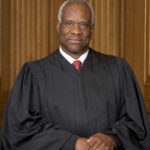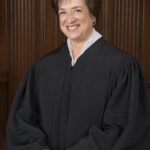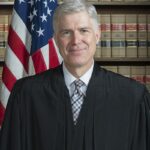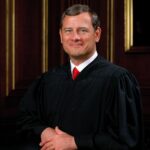Nine Justices make up the current Supreme Court: one Chief Justice and eight Associate Justices. The Honorable John Roberts, Jr. is the 17th Chief Justice of the United States, and there have been 104 Associate Justices in the Court’s history. Supreme Court justices serve lifetime appointments after being nominated by the president and approved by the Senate.
John Roberts, Jr., Chief Justice
On the court since: September 29, 2005
Born: January 27, 1955, in Buffalo, New York
Roberts grew up in Indiana and attended Harvard University, where he earned a Bachelor of Arts degree in History in 1976. He then attended Harvard Law School, where he earned a Juris Doctor degree in 1979.
After law school, Roberts clerked for Judge Henry Friendly of the United States Court of Appeals for the Second Circuit. He then clerked for Justice William Rehnquist of the Supreme Court of the United States.
In 1982, Roberts began working as an attorney in the Reagan administration, where he held a number of positions in the Department of Justice and the White House Counsel’s Office. He later worked as a partner at the law firm Hogan & Hartson, where he specialized in appellate litigation.
In 2003, President George W. Bush nominated Roberts to be a judge on the United States Court of Appeals for the District of Columbia Circuit. He was confirmed by the Senate later that year and served in that position until 2005, when President Bush nominated him to fill the vacancy left by the death of Chief Justice William Rehnquist on the Supreme Court.
Roberts’ confirmation hearings were relatively smooth, and he was confirmed by the Senate and sworn in as Chief Justice on September 29, 2005. As Chief Justice, Roberts has been known for his conservative views and his commitment to judicial restraint.
He has written opinions on a wide range of issues, including campaign finance reform, gun rights, and the Affordable Care Act. He is also known for his efforts to build consensus on the Court and his focus on maintaining the independence and integrity of the judiciary.
Clarence Thomas, Associate Justice
On the court since: October 23, 1991
Born: June 23, 1948, in Pin Point, Georgia
 Thomas grew up in a poor family and was raised by his grandparents after his father abandoned the family and his mother was unable to care for him and his siblings. Despite the challenges he faced, he excelled in his studies and was awarded a scholarship to attend the College of the Holy Cross in Worcester, Massachusetts.
Thomas grew up in a poor family and was raised by his grandparents after his father abandoned the family and his mother was unable to care for him and his siblings. Despite the challenges he faced, he excelled in his studies and was awarded a scholarship to attend the College of the Holy Cross in Worcester, Massachusetts.
After graduating in 1971, Thomas attended Yale Law School, where he became involved in conservative politics and joined the Black Students Alliance. He went on to work for Missouri Attorney General John Danforth and eventually became the assistant secretary for civil rights at the U.S. Department of Education.
In 1981, President Ronald Reagan appointed Thomas to lead the Equal Employment Opportunity Commission (EEOC), where he became known for his conservative views and opposition to affirmative action. In 1991, President George H.W. Bush nominated him to the Supreme Court, following the retirement of Justice Thurgood Marshall.
Thomas’s confirmation hearings were highly controversial, as he was accused of sexual harassment by Anita Hill, a former colleague from the EEOC. Despite the allegations, Thomas was confirmed by the Senate and was sworn in as a Supreme Court justice on October 23, 1991.
As a justice, Thomas has been known for his conservative views and strict interpretation of the Constitution. He has been a strong advocate for states’ rights, limited government, and individual liberty. He has written opinions on a wide range of issues, including affirmative action, gun rights, and the death penalty.
Ketanji Brown Jackson, Associate Justice
On the court since: October 3, 2022
Born: September 30, 1970, in Washington, D.C.
Jackson grew up in a family that valued education and public service. She attended Harvard University, where she earned a Bachelor of Arts degree in Government in 1992. She then attended Harvard Law School, where she earned a Juris Doctor degree in 1996.
After law school, Jackson served as a law clerk for Judge Bruce M. Selya of the United States Court of Appeals for the First Circuit. She then worked as an associate at the law firm of Morrison & Foerster in San Francisco, California, where she focused on appellate litigation and government investigations.
In 2005, Jackson began working as an Assistant Federal Public Defender in Washington, D.C. She represented indigent clients in criminal cases and also taught courses on trial advocacy and criminal law at the Georgetown University Law Center.
In 2010, President Barack Obama nominated Jackson to be a United States District Judge for the District of Columbia. She was confirmed by the Senate later that year and served in that position until her elevation to the D.C. Circuit in 2021.
During her time as a district judge, Jackson handled a wide range of cases, including civil rights, employment discrimination, and administrative law. She also gained national attention for her handling of high-profile cases, such as the lawsuit brought by the House of Representatives seeking to enforce a subpoena against former White House Counsel Don McGahn.
In 2021, President Joe Biden nominated Jackson to fill the vacancy left by Attorney General Merrick Garland on the D.C. Circuit. She was confirmed by the Senate on June 14, 2021, becoming one of the few African American women to serve on a federal appeals court.
Samuel Alito, Associate Justice
On the court since: January 31, 2006
Born: April 1, 1950, in Trenton, New Jersey
 Alito attended Princeton University, where he earned a Bachelor of Arts degree in 1972. He then attended Yale Law School, where he earned a Juris Doctor degree in 1975.
Alito attended Princeton University, where he earned a Bachelor of Arts degree in 1972. He then attended Yale Law School, where he earned a Juris Doctor degree in 1975.
After law school, Alito worked as a law clerk for Leonard I. Garth of the United States Court of Appeals for the Third Circuit. He then worked as an attorney in the U.S. Department of Justice’s Office of Legal Counsel, where he advised executive branch agencies on legal matters.
In 1987, President Ronald Reagan nominated Alito to be a United States District Judge for the District of New Jersey. He was confirmed by the Senate later that year and served in that position until 1990, when President George H.W. Bush nominated him to the United States Court of Appeals for the Third Circuit.
Alito served on the Third Circuit for 15 years, during which time he gained a reputation as a conservative jurist with a keen legal mind. In 2005, President George W. Bush nominated him to fill the vacancy left by the retirement of Justice Sandra Day O’Connor on the Supreme Court.
Alito’s confirmation hearings were contentious, as Democrats raised concerns about his conservative views and his record on civil rights and reproductive rights. Despite the opposition, Alito was confirmed by the Senate and was sworn in as a Supreme Court justice on January 31, 2006.
As a justice, Alito has been known for his conservative views and his strict interpretation of the Constitution. He has written opinions on a wide range of issues, including affirmative action, gun rights, and campaign finance reform. He has also been a strong advocate for judicial restraint and limiting the power of the federal government.
Elena Kagan, Associate Justice
On the court since: August 7, 2010
Born: April 28, 1960, in New York City
 Kagan grew up in a family that valued education and public service. She attended Princeton University, where she earned a Bachelor of Arts degree in History in 1981. She then attended Oxford University, where she earned a Master of Philosophy degree in Politics in 1983. Kagan then attended Harvard Law School, where she earned a Juris Doctor degree in 1986.
Kagan grew up in a family that valued education and public service. She attended Princeton University, where she earned a Bachelor of Arts degree in History in 1981. She then attended Oxford University, where she earned a Master of Philosophy degree in Politics in 1983. Kagan then attended Harvard Law School, where she earned a Juris Doctor degree in 1986.
After law school, Kagan worked as a law clerk for Judge Abner J. Mikva of the United States Court of Appeals for the District of Columbia Circuit. She then clerked for Justice Thurgood Marshall of the Supreme Court of the United States.
In 1989, Kagan began working as a professor at the University of Chicago Law School. She later moved to Harvard Law School, where she became a tenured professor in 1999. She also served as Dean of Harvard Law School from 2003 to 2009.
In 2009, President Barack Obama nominated Kagan to be Solicitor General of the United States. She was confirmed by the Senate later that year and served in that position until 2010, when President Obama nominated her to fill the vacancy left by the retirement of Justice John Paul Stevens on the Supreme Court.
Kagan’s confirmation hearings were relatively smooth, and she was confirmed by the Senate and sworn in as a Supreme Court justice on August 7, 2010. As a justice, Kagan has been known for her liberal views and her commitment to free speech and civil liberties.
She has written opinions on a wide range of issues, including campaign finance reform, gay rights, and the Affordable Care Act. Kagan is also known for her wit and humor, and she has developed a close working relationship with many of her colleagues on the Court.
Sonia Sotomayor, Associate Justice
On the court since: August 8, 2009
Born: June 25, 1954, in New York City
Sotomayor grew up in a housing project in the South Bronx, and she attended Princeton University, where she earned a Bachelor of Arts degree in History in 1976. She then attended Yale Law School, where she earned a Juris Doctor degree in 1979.
After law school, Sotomayor worked as a prosecutor in the Manhattan District Attorney’s Office. She later worked as a corporate litigator at the law firm Pavia & Harcourt, where she specialized in intellectual property and international commercial arbitration.
In 1992, President George H.W. Bush nominated Sotomayor to be a judge on the United States District Court for the Southern District of New York. She was confirmed by the Senate later that year and served in that position until 1998, when President Bill Clinton nominated her to be a judge on the United States Court of Appeals for the Second Circuit.
Sotomayor served on the Second Circuit until 2009, when President Barack Obama nominated her to fill the vacancy left by the retirement of Justice David Souter on the Supreme Court. Her confirmation hearings were relatively smooth, and she was confirmed by the Senate and sworn in as a Supreme Court justice on August 8, 2009.
As a justice, Sotomayor has been known for her liberal views and her commitment to social justice issues. She has written opinions on a wide range of issues, including affirmative action, voting rights, and criminal justice reform. She is also known for her willingness to engage with the public and for her efforts to inspire young people, particularly those from underprivileged backgrounds, to pursue careers in law.
Neil Gorsuch, Associate Justice
On the court since: April 10, 2017
Born: August 29, 1967, in Denver, Colorado
 Gorsuch grew up in Colorado and attended Columbia University, where he earned a Bachelor of Arts degree in Political Science in 1988. He then attended Harvard Law School, where he earned a Juris Doctor degree in 1991.
Gorsuch grew up in Colorado and attended Columbia University, where he earned a Bachelor of Arts degree in Political Science in 1988. He then attended Harvard Law School, where he earned a Juris Doctor degree in 1991.
After law school, Gorsuch clerked for Judge David B. Sentelle of the United States Court of Appeals for the District of Columbia Circuit and then for Justice Byron White of the Supreme Court of the United States.
Gorsuch later worked in private practice at the law firm Kellogg, Huber, Hansen, Todd, Evans & Figel. He also served as a principal deputy associate attorney general at the U.S. Department of Justice during the George W. Bush administration.
In 2006, President George W. Bush nominated Gorsuch to be a judge on the United States Court of Appeals for the Tenth Circuit. He was confirmed by the Senate later that year and served in that position until 2017, when President Donald Trump nominated him to fill the vacancy left by the death of Justice Antonin Scalia on the Supreme Court.
Gorsuch’s confirmation hearings were relatively contentious, but he was ultimately confirmed by the Senate and sworn in as a Supreme Court justice on April 10, 2017.
As a justice, Gorsuch has been known for his conservative views and his commitment to textualism and originalism. He has written opinions on a wide range of issues, including religious liberty, immigration, and the scope of executive power. He is also known for his efforts to promote civility and respectful dialogue on the Court and for his focus on the proper role of the judiciary in the American system of government.
Brett Kavanaugh, Associate Justice
On the court since: October 6, 2018
Born: February 12, 1965, in Washington, D.C.
 Kavanaugh grew up in the Washington, D.C. area and attended Yale University, where he earned a Bachelor of Arts degree in History in 1987. He then attended Yale Law School, where he earned a Juris Doctor degree in 1990.
Kavanaugh grew up in the Washington, D.C. area and attended Yale University, where he earned a Bachelor of Arts degree in History in 1987. He then attended Yale Law School, where he earned a Juris Doctor degree in 1990.
After law school, Kavanaugh clerked for Judge Walter Stapleton of the United States Court of Appeals for the Third Circuit and then for Justice Anthony Kennedy of the Supreme Court of the United States.
Kavanaugh later worked in private practice at several law firms, including Kirkland & Ellis and the law firm of which he was a partner, now known as Wiltshire & Grannis LLP. He also served as a staff secretary and senior associate counsel to President George W. Bush.
In 2006, President George W. Bush nominated Kavanaugh to be a judge on the United States Court of Appeals for the District of Columbia Circuit. He was confirmed by the Senate later that year and served in that position until 2018, when President Donald Trump nominated him to fill the vacancy left by the retirement of Justice Anthony Kennedy on the Supreme Court.
Kavanaugh’s confirmation process was highly contentious and controversial, with allegations of sexual assault being made against him during his Senate confirmation hearings. However, he was ultimately confirmed by the Senate and sworn in as a Supreme Court justice on October 6, 2018.
As a justice, Kavanaugh has been known for his conservative views and his commitment to textualism and originalism. He has written opinions on a wide range of issues, including abortion rights, environmental regulation, and executive power. He is also known for his focus on the proper role of the judiciary in the American system of government and his willingness to engage with the public on legal issues.
Amy Coney Barrett, Associate Justice
On the court since: October 27, 2020
Born: January 28, 1972, in New Orleans, Louisiana
 Barrett grew up in a family of seven children and attended Rhodes College, where she earned a Bachelor of Arts degree in English in 1994. She then attended Notre Dame Law School, where she graduated magna cum laude with a Juris Doctor degree in 1997.
Barrett grew up in a family of seven children and attended Rhodes College, where she earned a Bachelor of Arts degree in English in 1994. She then attended Notre Dame Law School, where she graduated magna cum laude with a Juris Doctor degree in 1997.
After law school, Barrett clerked for Judge Laurence Silberman of the United States Court of Appeals for the District of Columbia Circuit and then for Justice Antonin Scalia of the Supreme Court of the United States.
Barrett later worked in private practice at the law firm of Miller, Cassidy, Larroca & Lewin and then as a professor at Notre Dame Law School. She also served as a visiting professor at the University of Virginia School of Law and as a member of the Federalist Society and other conservative legal organizations.
In 2017, President Donald Trump nominated Barrett to be a judge on the United States Court of Appeals for the Seventh Circuit. She was confirmed by the Senate later that year and served in that position until 2020, when President Trump nominated her to fill the vacancy left by the death of Justice Ruth Bader Ginsburg on the Supreme Court.
Barrett’s confirmation process was also highly contentious, with critics expressing concern about her conservative views and her potential impact on issues such as abortion rights and healthcare. However, she was ultimately confirmed by the Senate and sworn in as a Supreme Court justice on October 27, 2020.
As a justice, Barrett is known for her conservative views and her commitment to textualism and originalism. She has written opinions on a range of issues, including gun rights, religious liberty, and the Affordable Care Act. She is also known for her focus on the proper role of the judiciary in the American system of government and her belief in the importance of the Constitution as a document that should be interpreted according to its original meaning.


